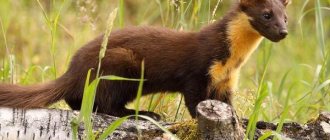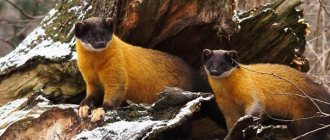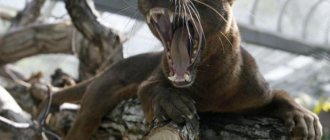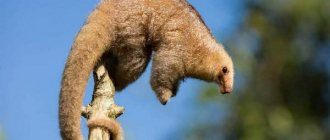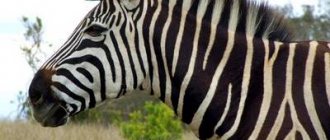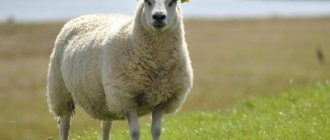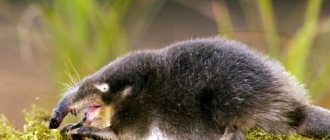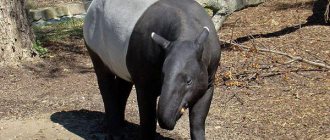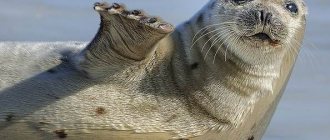- Wild animals
- >>
- Mammals
The marten is a medium-sized predatory mammal with a beautiful body and a large tail.
Representatives of the mustelid family are excellent hunters, have developed paw motor skills, as well as sharp fangs and claws that can cause lacerations to humans. Adults engage in gymnastics, which allows them to live up to 20 years, and the cubs constantly play, making cooing sounds.
Description and origin of the species
The marten genus emerged approximately 7 million years ago. The animal was first described by Carl Linnaeus in 1758. He described the European marten, calling the animal Martes martes, and the sable, giving the species the name Martes zibellina. The Latin name martes was borrowed from the old French and German martre.
The name marten is a diminutive derivative of the word kuna. According to one version, the word kuna was borrowed from the ancient Prussian name for the animal caune. According to another version, the word kuna comes from the German cuncan,
which means "brown" and is a reference to the color of the animal's fur.
What does a marten look like?
The marten has a long, elongated body and a graceful build. The ears are round, quite large relative to the size of the body, long neck, small pointed muzzle, short legs. The tail is fluffy and quite long - it accounts for up to 2/3 of the body size. The marten is the only animal from the Mustelidae family with semi-retractable claws. This allows the predator to climb trees well, without losing speed when running.
The animal is no larger than a cat. Body length varies from 40 to 80 cm depending on the species, plus a tail 15-30 cm long. The animal weighs from 0.5 to 5.7 kg. Males usually weigh more than females. The largest yellow-breasted marten, males weigh on average from 2.5 to 5.7 kg. The smallest is the American marten. The weight of an adult starts from 0.5 kg.
In winter, the marten's fur is much thicker and longer; in summer, the fur is short and sparser. The color varies greatly depending on the species and its habitat, from light brown to brown and dark brown. There is often a light brown, white, gray or yellow patch on the chest and throat.
Peculiarities
The marten is an agile and agile predator. Despite its short legs, it is capable of moving at high speed with large leaps (up to 4 m in length), leaving traces of its hind legs on the marks of its forelimbs.
With the same ease, the animal moves to heights, digging its claws into the bark of a tree. In this case, the feet tend to rotate to the sides by 180 degrees. The marten can half hide its claws inside and release them at the time of hunting or danger.
The tail not only decorates the animal, but is also an important tool. It helps the body maintain balance in an upright position, move boldly along thin branches and jump from one tree to another. Thanks to its tail, the marten can fall softly from great heights without causing harm to itself.
On the stomach, close to the tail, there is a special gland called the anal gland. It secretes a special liquid - a secret. Females have 2 mammary glands. The soles of the marten's paws are bare in summer, and in late autumn they begin to grow hair, thanks to which the animal easily moves through the snow without falling into snowdrifts. The coat also varies by season - in winter the fur is long and silky, with an undercoat of light colors. And in the summer months it thins out, becomes shorter and coarser.
The marten has a keen sense of smell, excellent hearing, and moves freely in the dark. She has well-developed motor skills of her limbs. This animal can swim, but tries to avoid water, preferring to be at heights or move on land. Males are more active and always larger than females.
These predators are capable of making a variety of sounds - a menacing growl or abrupt bark, like dogs, or meowing and howling, like cats. The marten in the photo looks like a cute, defenseless creature, but this is a deceptive impression - it is an insidious predator and knows how to stand up for itself. Kills prey with a deep bite to the back of the head.
Types of martens
The genus Marten (Martes) includes 7 species: American, yellow-breasted (harza), stone, Nilgiri harza, forest, Japanese and sable.
American marten (Martes americana)
It lives in North America, from Canada and Alaska to New Mexico. In Canada and Alaska, the animal is very common. In the United States, the population has declined significantly, and the animal's habitat has narrowed to the mountain ranges of the western United States. Color ranges from pale yellow to black and tan. There is usually a straw-yellow or orange patch on the throat and chest. The animal weighs from 0.5 to 1.4 kg, is 50-70 cm long with a short but bushy tail.
Yellow-breasted marten, or Ussuri marten, or marten (Martes flavigula)
Kharza lives in Asia - in India, Afghanistan, Pakistan, Nepal, Bhutan, Korea, southern China, Taiwan and the Russian Far East. In Southeast Asia, the animal is found in Bangladesh, Thailand, Vietnam, Myanmar, Cambodia, Laos and Malaysia. In Nepal, the animal was seen at an altitude of 4,500 meters above sea level.
Kharza is the largest marten. Males weigh 2.5-5.7 kg, females on average from 1.6 to 3.8 kg. In appearance it resembles a stone marten, but differs from it in its unusual yellowish color and baculum (has a bone in the penis). The tail is very long and less bushy than other species, and makes up about 2/3 of the animal's body length.
Nilgiri marten (Martes gwatkinsii)
The Nilgiri marten is the only species found in southern India. Lives in the Nilgiri hills and Western Ghats. A fairly large marten weighing about 2 kg and 55-70 cm long, slightly inferior in size to the harza. The animal is easily distinguished by its bright yellow or orange spot on its throat. Listed in the International Red Book as a vulnerable species.
Sable (Martes zibellina)
The animal lives in Russia east of the Ural Mountains, and is also found in northern Mongolia, eastern Kazakhstan, China, North Korea and Japan. Previously he also lived in the European part of Russia, Poland and Scandinavia. Sable fur is still highly valued in the fur market.
Pine marten or European marten (Martes martes)
The European pine marten lives only in dense forests. It is found throughout Europe, with the exception of England, where the animal was exterminated, and in the Middle East. The animal is medium in size, weighing about 1.5-1.7 kg and body length about 50 cm. The color is usually light or dark brown, with a pale or yellowish patch on the chest.
Stone marten or white-breasted marten (Martes foina)
The stone marten is similar in appearance to the forest marten, but differs slightly from the latter in having a longer tail, an elongated head and short, widely spaced ears. The animal's nose is peach or light gray in color, while the pine marten's nose is black or dark gray. The stone marten's legs are shorter than those of the pine marten, so when moving it minces finely, like a ferret, and does not move forward by jumping, like a sable or pine marten.
The stone marten is slightly smaller in size than the forest marten. The fur of the stone marten is coarser than that of the forest marten, and the undercoat is thinner. The color is darker than that of the pine marten, while the patch on the chest is entirely white, hence the name. Unlike the pine marten, which can only live in the forest, the stone marten adapts much better to environmental conditions and is able to live in open spaces.
Lives in Europe and Central Asia. Also found in Wisconsin. In the 1940s, several individuals escaped from a farm in the United States and took root in the wild, giving rise to the North American population. In Europe, it lives in Spain, Portugal and Central Europe, but does not live in the British Isles, Scandinavia, the Baltic countries and the European part of Russia. Lives in the Middle East and Central Asia - Afghanistan, Pakistan, Bhutan, India, Nepal and Burma. In Russia, the animal is found in Altai.
Japanese marten (Martes melampus)
The closest relative of the sable. Lives exclusively in Japan, although previously it was also seen in South Korea. The marten is medium-sized - about 50 cm in length, and weighing from 1 to 1.5 kg. Color ranges from pale yellow to dark brown, with a pale patch on the throat.
Second place in diet
What does the marten eat when there are not enough voles in its habitat? During such periods, she begins to hunt for grouse birds. Thus, partridge, black grouse and hazel grouse occupy second place in the animal’s diet. And here the predator has his own preferences. In this group, the hazel grouse plays a predominant role. The marten preys on it in more than fifty percent of cases. There is an explanation for this. The fact is that the hazel grouse lives, as a rule, in the dark coniferous taiga. The marten also chooses these same places for its residence.
It is interesting that grouse are quite rare in the predator’s summer diet. In winter, they make up almost twenty-five percent, because during the cold season they spend most of the day in the snow. At the same time, their hearing and vision are significantly reduced. In such conditions, catching them becomes much easier.
What does a marten eat?
Martens are omnivores and feed on both animal and plant foods. The animal's diet usually includes:
- nuts, berries, seeds, honey, fruits and vegetables - pears, tomatoes, grapes, raspberries, cherries;
- hares and rabbits;
- rodents - mice, rats, hamsters, voles;
- reptiles - snakes, lizards;
- birds - sparrows and passerines, mountain turkeys, galliformes, owls and barn owls, pheasants;
- deer - mundjaks, musk deer, sika deer, young elk, roe deer;
- fish and shellfish;
- carrion - the remains of prey from wolves, bears and tigers.
Animals often supplement their diet with seeds and insects. Males tend to target larger prey, while females are content with smaller game and carrion. In search of carrion, animals often follow larger predators, picking up the remains of prey from bears, wolves and tigers. The stone marten eats insects and plant foods much more often than other species, European forest and sable; in winter the animal feeds mainly on plants.
The yellow-breasted marten, as the largest species, attacks larger prey - small deer and mountain goats, wild boar and panda cubs, and even smaller martens, such as the marten. The American marten feeds primarily on mice, voles, white-footed hamsters and snowshoe hares. The sable, unlike other species, occasionally eats fish and shellfish.
In general, animals are not inclined to hunt livestock, but some animals deliberately hunt poultry. When hunting birds, predators usually look for bird nests, eat the eggs, and then the owners of the nest. Animals are important seed carriers for the ecosystem.
Where does it live?
The marten's habitat covers the northern and central parts of North America, almost all of Europe and certain regions of Asia. The predator is also found on the islands of Kalimantan, Sumatra, and Java. Unlike other representatives of the mustelid family, the animal is not found in South America.
OPOSSUM
Where does he live?
Stone marten
The natural habitat of most species of martens is lowland and mountain forests with a large number of trees. You can meet the predator in pine or mixed forests. Animals prefer to settle in areas with a large number of tall trees and dead wood, small forest clearings, and dense undergrowth.
Some species live in mountainous areas covered with dense vegetation. Natural zones suitable for the life of a predator also include dry subtropical forests and forest-steppes.
Character and lifestyle
Animals generally lead a solitary lifestyle, meeting with individuals of the opposite sex only during the mating season. The exception is the yellow-breasted marten. Representatives of this species often hunt in pairs, as well as in small groups of 3-4 individuals. The pine and stone martens are active mainly at night, the yellow-breasted and Nilgiri martens are active during the day, and sables hunt mainly at dusk. The American marten is active both day and night, depending on the time of year, habitat and the behavior of larger predators.
Each adult predator usually has its own territory, which it marks with excrement. The stone marten is a more territorial animal than the pine marten. The size of the animal's hunting range varies depending on the terrain, averaging from 4 to 30 square kilometers. The predator constantly patrols its territory and can walk 10 km a day in search of food. Animals rest in dens - in the hollow of a tree, in rock crevices, between the roots of trees. The shelter can be either permanent or temporary if the animal has to travel frequently.
Martens are excellent tree climbers and can jump between branches at a distance of up to 8 meters. Stone martens and yellow-breasted martens often hunt on the ground. The animal swims well and often settles along the river bank. The animal has excellent hearing and sense of smell, which helps them in hunting.
Interesting Facts
The marten is a small and agile predator. There is no crack that a flexible rogue cannot fit through. Some species are considered elusive and virtually nothing is known about their lifestyle. Sable, mountain, forest and Ussuri species are considered well studied.
Interesting Facts:
- At night, in the light of the moon or a dim lantern, the marten's eyes glow red. Because of this, in some countries it is called the “forest devil.”
- Martens are the only members of the family that can retract their claws halfway.
- Most species are omnivores.
- Representatives of the family make winter supplies and hide food in empty hollows and rock crevices.
- The marten has difficulty adapting to captivity, so they try not to keep them locked up even in zoos and nurseries.
- Marten fur is considered one of the most expensive in the world.
- Marten is the mascot of the Salavat Yulaev hockey club.
- Little sneaks often settle near human habitation. But such a neighborhood does not bring joy to people. Nimble predators destroy poultry houses, chew wires, eat rubber and plastic parts in mechanisms, and also pull out soft and warm materials from the casing for their nests. Motorists and home owners near forested areas can insure themselves against damage caused by martens.
- In ancient times, marten skin had a fixed monetary value. One unit (skin) was called kuna.
- Martens mark their areas using anal glands. The musky secretion has an unpleasant odor with floral notes.
Reproduction and young
The mating season usually occurs in the summer, from mid-June to mid-August, and is accompanied by fierce fights between males for the female. Pregnancy lasts up to 300 days. The fertilized egg enters the uterus in late winter, approximately 8 months after mating. Direct fetal development takes about 30-60 days, depending on the species. Childbirth usually occurs in March-April, the female gives birth in a tree hollow lined with leaves and grass.
In one litter, from 3 to 7 cubs are born, blind and almost bald, weighing about 30 grams and 10-12 cm long. The mother feeds them with milk for up to 2 months. At the age of 3-4 months, young martens are already indistinguishable from adults and set off to live independently. Sexual maturity occurs at 1 year of age, although successful mating usually does not occur until 2 years of age.
Sables can interbreed with pine martens, resulting in a hybrid called kidus. Hybrids are usually sterile, although there has been a recorded case where a female kidus gave birth to a male pine marten.
The basis of the diet
What does the marten eat in its habitat? The main food in its diet is voles. The predator eats them not only during the warm season. The animal also catches voles in winter. Moreover, in the winter diet of the predator, their number decreases only by insignificant percentages. This indicates the fact that even a meter thick snow cover is not a serious obstacle for the marten when pursuing its victims. In those years when there are especially many voles, the forest predator is the most well-fed. At the same time, its daily range is reduced to a minimum.
Natural enemies
Martens are periodically hunted by larger predators - foxes, wolves, lynxes, cougars, wolverines, and coyotes. Eagles and large owls pose a greater danger to young animals. A notable competitor of the predator is the ferret; in a fight between these animals, the marten usually wins.
Animals often compete with each other for prey - American martens kill their relatives, yellow-chested hunt sables. The only species that successfully coexists with its relatives is the stone marten, since it feeds mainly on insects and plant foods.
Sweet treat
What does a marten eat? The animal loves honey very much. The predator visits the hollow in which wild bees live until it has completely eaten all the reserves. Near the tree where a wintering bee colony was discovered by a marten, you can see pieces of honeycombs and even the frozen striped workers themselves in the snow. Of course, not every marten finds honey. This is why he is nothing more than a random catch.
If in the summer the pine marten destroys nests built by earth bees or wasps, then as a special delicacy it eats insect larvae with great greed.
Population and protection of the species
All 7 species of marten are listed in the IUCN Red List, 6 of them with the status of “least concern” and the Nilgiri harza as a “vulnerable species”.
Despite the presence of natural enemies in the wild, the main threat to the animal is humans. The main factors reducing the population are hunting for pelts and poaching, as well as habitat loss and fragmentation due to deforestation.
